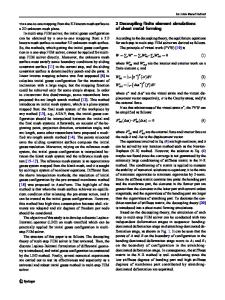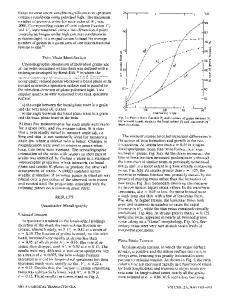A Method for Direct Measurement of Multiaxial Stress-Strain Curves in Sheet Metal
- PDF / 439,375 Bytes
- 8 Pages / 594 x 792 pts Page_size
- 85 Downloads / 324 Views
ODUCTION
ACCURATE sheet metal forming die designs rely on numerical models, which in turn rely on accurate constitutive laws and experimental data for the material being deformed. Of particular interest to those modeling sheet metal forming processes using the finite element method (FEM) is the shape of the yield locus in stress space, and in particular how the shape, size, and location of the locus changes with strain level. Experimental data in this area would allow modelers to predict and use a forming limit diagram (FLD) formalism in stress space rather than strain space.[1] This would allow the prediction of maximum allowable stresses in a part being formed, which is a potentially more intrinsic property than the maximum strains, which have been shown to be highly path dependent[2] and valid only for linear strain paths (which are seldom seen in production sheet forming[1]). To map out the yield locus, one must be able to detect yield in a sample that is being loaded along some multiaxial strain path and simultaneously determine the stresses being imposed. The easiest path to measure is uniaxial tension, where the ratio of principal strains (q = e2/e1) equals –0.5, and the true stress, defined as current load divided by current cross-sectional area, is assumed uniform across the gage section up to the point of localization prior to failure. Measuring the stressstrain behavior along other strain paths is much more difficult and has been attempted in several ways. Tests involving application of simultaneous tension/torsion or internal pressure/torsion on tubular samples have been T. FOECKE, Staff Materials Scientist, M.A. IADICOLA and S.W. BANOVIC, Staff Scientists, and A. LIN, Guest Researcher, are with the Metallurgy Division, Department of Commence, National Institute of Standards and Technology, Technology Administration, Gaithersburg, MD 20899, USA. Contact e-mail: [email protected] Manuscript submitted March 21, 2006. 306—VOLUME 38A, FEBRUARY 2007
used to probe the yield locus,[3,4] but this sample geometry is not readily adaptable to flat sheet samples. Other common methods include hydraulic bulge and cruciform sheet testing. Hydraulic bulge tests are able to produce near balanced biaxial stress states via knowledge of the applied pressure,[5] where the stress at the outer surface is calculated using membrane theory. However, this geometry indufces significant out-of-plane bending, which has been shown to affect forming limits[6] and would produce a gradient in the applied stress through the thickness of the sheet. Additionally, in bulge testing, the deformation varies radially, from balanced biaxial tension at the crown to plane strain near the clamped edge. This results in a radial thickness variation. The stress at a point must be calculated based on the local thickness dimension, which is calculated during the test using the measured average strain and assuming a constant volume in the local area of measurement. Cruciform sheet metal samples have been deformed using orthogonally oriented hydraulic rams,[7] prod
Data Loading...











